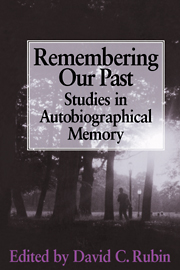Book contents
- Frontmatter
- Contents
- List of contributors
- 1 Introduction
- Part I Approaches
- Part II Accuracy
- Part III Emotions
- Part IV Social functions
- 11 Remembering as communication: A family recounts its past
- 12 Group narrative as a cultural context of autobiography
- 13 Memories of college: The importance of specific educational episodes
- Part V Development and disruption
- Subject index
- Author index
12 - Group narrative as a cultural context of autobiography
Published online by Cambridge University Press: 14 October 2009
- Frontmatter
- Contents
- List of contributors
- 1 Introduction
- Part I Approaches
- Part II Accuracy
- Part III Emotions
- Part IV Social functions
- 11 Remembering as communication: A family recounts its past
- 12 Group narrative as a cultural context of autobiography
- 13 Memories of college: The importance of specific educational episodes
- Part V Development and disruption
- Subject index
- Author index
Summary
The narration of a life history provides a special intersect where two richly elaborated psychological systems meet. The first involves the processes used in recounting or interpreting narrative itself; the second concerns processes involved in retrieving memories. To understand how a life history is told or how it is being interpreted is virtually impossible without a grasp of narrative structure. We have discussed narrative processes elsewhere (Feldman, 1991b; Bruner, 1990, 1991), and need only note two points here. The first is that in autobiography, as in all narrative, the product is a highly constructed one. The second is that how a narrative is constructed, its form or pattern, provides us with a basis for understanding or interpreting it – whether the interpretation is accurate or not, in whatever sense it may be accurate. Put bluntly, this is to say that narrative patterning does not “get in the way” of accurate autobiographic reporting or interpreting, but rather, provides a framework for both telling and understanding (Rubin, in press). This creates an anomaly similar to the one Bartlett (1932) introduced into the study of memory years ago, and we shall return to it presently. It is an anomaly that still plagues cognitive science today when it attempts to deal with such notions as frames and scripts (e.g., Bransford & Johnson, 1972; Pichert & Anderson, 1977).
Students of memory have become increasingly interested in autobiographical memory in the last decade. By autobiographical memory some mean any situated, real-life memory; others mean only personal memories, things in which, somehow, self was engaged (Rubin, 1986, introduction).
- Type
- Chapter
- Information
- Remembering our PastStudies in Autobiographical Memory, pp. 291 - 317Publisher: Cambridge University PressPrint publication year: 1996
- 26
- Cited by



